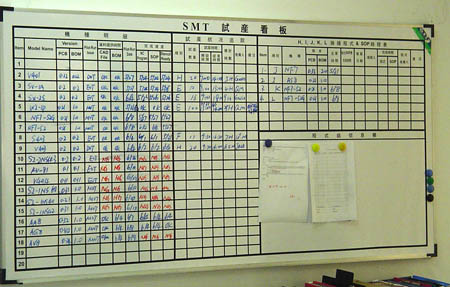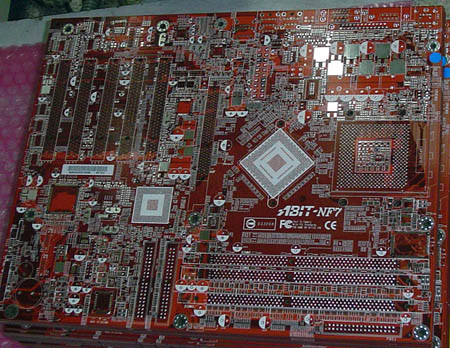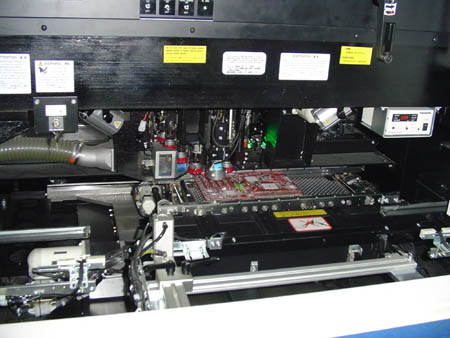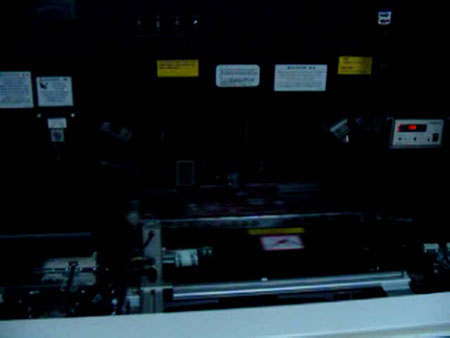The Birth of an Abit NF7 - A Factory Tour
by Kristopher Kubicki on June 11, 2004 10:12 PM EST- Posted in
- Motherboards
SMT
And now, the part that we have all been waiting for - the birth of an NF7. Unfortunately, the unison of science and art comes particularly unceremoniously in crates of 1000. Since Abit has no PCB production facilities, four- and six-layer motherboards are shipped from out-sourced facilities, pre-traced and pre-painted. Abit Taiwan designs the PCB and sends the schematics to an OEM factory. The factory manufactures and delivers the PCB to Rolly. For a quick primer on how the PCB is constructed, check out the primer that we gave in our ECS factory tour last year.Before walking onto the SMT lines, we are presented with a small office that controls the CAD/CAM devices on the floor. This mission control board shows when each machine was last tested, from where and when the PCB for that production came, and other process vitals.
Above is an Abit NF7 PCB as Rolly receives it. These boards have already been drilled and have passed electrical quality assurance tests at the OEM. The Rolly facility will mount components via SMT, manual labor and then package the board at this facility.
SMT is a term used frequently in any sort of electrical assembly. It stands for "surface-mount technology". As motherboard speed increases, their feature set and complexity increases even faster, although disproportionately . Motherboards like the NF7 have upwards of several thousand integrated circuits (ICs) under a millimeter in length, soldered onto the traces of the motherboard. Although labor is cheap in China, such precision and finesse are required to place delicately the thousands of resistors, ceramic capacitors and other integrated circuits (SMDs) that only a preprogrammed machine can accomplish. Below, you can see one of Abit's two-years-old SMT machines placing components on the NF7 PCB.
A colleague of mine recently described SMT as "a high-powered machine gun spitting ICs onto a board with insane precision." There really is not a more accurate description. Since SMDs are stamped onto the board at such high speeds, they are loaded into the SMT machine using a special tape feeder. This is very similar to the manner in which ammunition is fed into a machine gun. Below is a quick video sample of how the entire process looks in real time.














19 Comments
View All Comments
fengpc - Sunday, August 22, 2004 - link
Visited Suzhou two times, it's a nicer area than ShenZhen IMO. The industry zones look cleaner and more organized. However I believe they will have power issues just like other mfg zones in China soon. Nice article, enjoy reading it.KristopherKubicki - Wednesday, June 16, 2004 - link
http://images.anandtech.com/reviews/motherboards/a...Kristopher
Glenngalata - Wednesday, June 16, 2004 - link
An excellent overview of what is involved in the motherboard manufacturing world.The key point to this article is the availability of cheap labor. There would never be a way to produce an American made motherboard product that would be cost effective against the the far east produced items which is unfortunate.
Another key point to the article is the comment of the ABIT quality control being obviously tighter than that of ECS. Anyone who has owned an ECS product can attest to the fact that the lemon rate for their products distinctly shows the quality difference going against ECS. They may be a larger company but they did not get there by catering to buyers who care about any level of satisfaction. Maybe this is why ECS was voted one of the worst quality control entities in the entire motherboard segment.
The choice is yours but ABIT scored my vote on this one.
MadAd - Wednesday, June 16, 2004 - link
yeah please, whats the url?KristopherKubicki - Tuesday, June 15, 2004 - link
14: I have it - its 23MB though. send me an email, i will drop it somewhere you can pick it up.Kristopher
manzana - Tuesday, June 15, 2004 - link
Interesting article. Wish there was a video of that person building the pc within 1 minute ;)araczynski - Monday, June 14, 2004 - link
very nice article, makes me miss my days in the industrial automation field, but not the pressures :)KristopherKubicki - Monday, June 14, 2004 - link
Jaramin,Like i said in the ECS article also, workers work about 8 to 9 hours a day and are provided with meals/housing. There is very little variation between any company that operates out of China; its kind of all about standardized. If you have any other specific political or economic questions feel free to ask.
Kristopher
Jaramin - Monday, June 14, 2004 - link
It would be nice if some more information about the ethical or human ressource aspect of the manufacture would be included. The only thing that was provided here is that the workers are paid 100$/month...Some of us like to know what is the actual human cost of a product. Knowing that company A offers better working conditions than B could certainly weight on my choice of boards.
ViRGE - Monday, June 14, 2004 - link
While I don't really have anything of substance to say, I would like to say that this is one of those "wow, that's cool" kind of articles that are always great to see. Kudos for doing these kinds of things, guys.